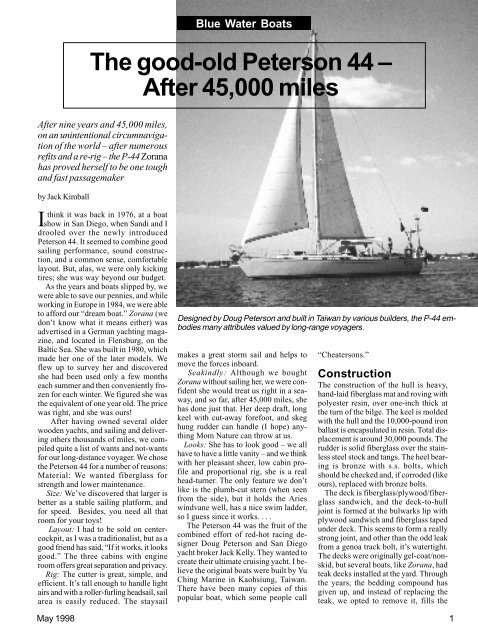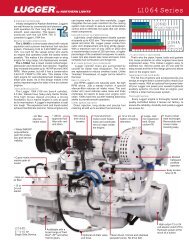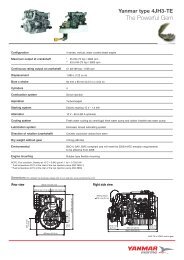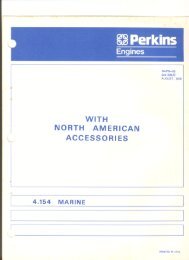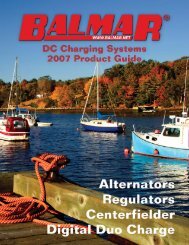The good-old Peterson 44 – After 45,000 miles
The good-old Peterson 44 – After 45,000 miles
The good-old Peterson 44 – After 45,000 miles
You also want an ePaper? Increase the reach of your titles
YUMPU automatically turns print PDFs into web optimized ePapers that Google loves.
<strong>After</strong> nine years and <strong>45</strong>,<strong>000</strong> <strong>miles</strong>,<br />
on an unintentional circumnavigation<br />
of the world <strong>–</strong> after numerous<br />
refits and a re-rig <strong>–</strong> the P-<strong>44</strong> Zorana<br />
has proved herself to be one tough<br />
and fast passagemaker<br />
by Jack Kimball<br />
I<br />
think it was back in 1976, at a boat<br />
show in San Diego, when Sandi and I<br />
drooled over the newly introduced<br />
<strong>Peterson</strong> <strong>44</strong>. It seemed to combine <strong>good</strong><br />
sailing performance, sound construction,<br />
and a common sense, comfortable<br />
layout. But, alas, we were only kicking<br />
tires; she was way beyond our budget.<br />
As the years and boats slipped by, we<br />
were able to save our pennies, and while<br />
working in Europe in 1984, we were able<br />
to afford our “dream boat.” Zorana (we<br />
don’t know what it means either) was<br />
advertised in a German yachting magazine,<br />
and located in Flensburg, on the<br />
Baltic Sea. She was built in 1980, which<br />
made her one of the later models. We<br />
flew up to survey her and discovered<br />
she had been used only a few months<br />
each summer and then conveniently frozen<br />
for each winter. We figured she was<br />
the equivalent of one year <strong>old</strong>. <strong>The</strong> price<br />
was right, and she was ours!<br />
<strong>After</strong> having owned several <strong>old</strong>er<br />
wooden yachts, and sailing and delivering<br />
others thousands of <strong>miles</strong>, we compiled<br />
quite a list of wants and not-wants<br />
for our long-distance voyager. We chose<br />
the <strong>Peterson</strong> <strong>44</strong> for a number of reasons:<br />
Material: We wanted fiberglass for<br />
strength and lower maintenance.<br />
Size: We’ve discovered that larger is<br />
better as a stable sailing platform, and<br />
for speed. Besides, you need all that<br />
room for your toys!<br />
Layout: I had to be s<strong>old</strong> on centercockpit,<br />
as I was a traditionalist, but as a<br />
<strong>good</strong> friend has said, “If it works, it looks<br />
<strong>good</strong>.” <strong>The</strong> three cabins with engine<br />
room offers great separation and privacy.<br />
Rig: <strong>The</strong> cutter is great, simple, and<br />
efficient. It’s tall enough to handle light<br />
airs and with a roller-furling headsail, sail<br />
area is easily reduced. <strong>The</strong> staysail<br />
Blue Water Boats<br />
<strong>The</strong> <strong>good</strong>-<strong>old</strong> <strong>Peterson</strong> <strong>44</strong> <strong>–</strong><br />
<strong>After</strong> <strong>45</strong>,<strong>000</strong> <strong>miles</strong><br />
Designed by Doug <strong>Peterson</strong> and built in Taiwan by various builders, the P-<strong>44</strong> embodies<br />
many attributes valued by long-range voyagers.<br />
makes a great storm sail and helps to<br />
move the forces inboard.<br />
Seakindly: Although we bought<br />
Zorana without sailing her, we were confident<br />
she would treat us right in a seaway,<br />
and so far, after <strong>45</strong>,<strong>000</strong> <strong>miles</strong>, she<br />
has done just that. Her deep draft, long<br />
keel with cut-away forefoot, and skeg<br />
hung rudder can handle (I hope) anything<br />
Mom Nature can throw at us.<br />
Looks: She has to look <strong>good</strong> <strong>–</strong> we all<br />
have to have a little vanity <strong>–</strong> and we think<br />
with her pleasant sheer, low cabin profile<br />
and proportional rig, she is a real<br />
head-turner. <strong>The</strong> only feature we don’t<br />
like is the plumb-cut stern (when seen<br />
from the side), but it h<strong>old</strong>s the Aries<br />
windvane well, has a nice swim ladder,<br />
so I guess since it works. . . .<br />
<strong>The</strong> <strong>Peterson</strong> <strong>44</strong> was the fruit of the<br />
combined effort of red-hot racing designer<br />
Doug <strong>Peterson</strong> and San Diego<br />
yacht broker Jack Kelly. <strong>The</strong>y wanted to<br />
create their ultimate cruising yacht. I believe<br />
the original boats were built by Yu<br />
Ching Marine in Kaohsiung, Taiwan.<br />
<strong>The</strong>re have been many copies of this<br />
popular boat, which some people call<br />
“Cheatersons.”<br />
Construction<br />
<strong>The</strong> construction of the hull is heavy,<br />
hand-laid fiberglass mat and roving with<br />
polyester resin, over one-inch thick at<br />
the turn of the bilge. <strong>The</strong> keel is m<strong>old</strong>ed<br />
with the hull and the 10,<strong>000</strong>-pound iron<br />
ballast is encapsulated in resin. Total displacement<br />
is around 30,<strong>000</strong> pounds. <strong>The</strong><br />
rudder is solid fiberglass over the stainless<br />
steel stock and tangs. <strong>The</strong> heel bearing<br />
is bronze with s.s. bolts, which<br />
should be checked and, if corroded (like<br />
ours), replaced with bronze bolts.<br />
<strong>The</strong> deck is fiberglass/plywood/fiberglass<br />
sandwich, and the deck-to-hull<br />
joint is formed at the bulwarks lip with<br />
plywood sandwich and fiberglass taped<br />
under deck. This seems to form a really<br />
strong joint, and other than the odd leak<br />
from a genoa track bolt, it’s watertight.<br />
<strong>The</strong> decks were originally gel-coat/nonskid,<br />
but several boats, like Zorana, had<br />
teak decks installed at the yard. Through<br />
the years, the bedding compound has<br />
given up, and instead of replacing the<br />
teak, we opted to remove it, fills the<br />
May 1998 1
zillions of holes and put nonskid back on.<br />
For air circulation, the P-<strong>44</strong> has 14 opening<br />
bronze ports; early boats had only 10<br />
with fixed portlights amidships and teak<br />
trim rings instead of the bronze that Zorana<br />
has. <strong>The</strong>re are three opening hatches<br />
(early boats had wood, later aluminum)<br />
and two companionways. All in all,<br />
there’s enough air flow to keep you cool<br />
in all but the stillest days. But that’s why<br />
they invented fans!<br />
<strong>The</strong> P-<strong>44</strong>s were shipped without rigs<br />
and then set up where they were, so that<br />
the California boats were usually Kenyan<br />
spars and Nav-tec rigging. Zorana, which<br />
was shipped to Germany, has Reckman/<br />
Shultz spars and Nav-tec rigging, plus<br />
special roller-furling gear built for Hood<br />
by Reckman/Shultz. <strong>The</strong> stainless-steel<br />
chainplates pass through the deck and<br />
are securely bolted to the hull/frames.<br />
Because these boats are over 18 years<br />
<strong>old</strong> now, all the bolts should be pulled,<br />
inspected, and replaced if necessary. At<br />
the same time, you should pull the genoatrack<br />
bolts and check them too.<br />
Cockpit & deck<br />
<strong>The</strong> cockpit is one of our favorite features.<br />
We enjoy warm-weather cruising<br />
and virtually live outside. <strong>The</strong> P-<strong>44</strong>’s cockpit<br />
is comfortable and secure, with over<br />
six-foot side cushions (for naps), bridgedeck<br />
forward, and our custom made propane<br />
box/helm seat aft. With a dodger and<br />
bimini with side flaps, we can enjoy most<br />
weather conditions. <strong>The</strong>re’s plenty of storage<br />
in the pukas, port and starboard, and<br />
the port seat locker is quite large. <strong>The</strong><br />
starboard seat locker opens to allow air<br />
to the walk-through for those miserable<br />
days when the engine must be attended<br />
to. <strong>The</strong> cockpit sole is a soft patch that<br />
can be removed for those major engineroom<br />
jobs.<br />
Steering is via a Yacht Specialties wheel<br />
and binnacle with cables running down<br />
the port side aft to the bronze quadrant.<br />
Despite the long run, about 20 feet, the<br />
steering feels <strong>good</strong> with normal feedback.<br />
<strong>The</strong> emergency filler fits onto the rudderpost<br />
beneath the aft bunk. This is not the<br />
best setup, and you certainly wouldn’t<br />
want to steer this way for long, so carry a<br />
spare cable.<br />
<strong>The</strong> deck layout is <strong>good</strong>, with wide side<br />
decks, high lifelines, with securelymounted<br />
stanchions and bow and stern<br />
pulpits; however, we had to move ours<br />
over to accommodate the Aires windvane.<br />
<strong>The</strong> aft deck is great <strong>–</strong> <strong>good</strong> for sun bath-<br />
ing, fishing, leaving your diving gear, and<br />
the like. We see a lot of P-<strong>44</strong> owners clutter<br />
this area up with deck lockers, life<br />
rafts and what not; they don’t know what<br />
they’re missing. <strong>The</strong>re is a teak splashguard<br />
for the dodger and a teak garage<br />
for the main hatch. Around the mast we<br />
have sissy bars, which are optional, but<br />
we love them for the security when reefing<br />
the mainsail.<br />
Rig & Sails<br />
<strong>The</strong> rig was designed for light California<br />
winds, so there is plenty of it. <strong>The</strong><br />
mast is 60 feet above the waterline, keelstepped,<br />
double-spreader with 3/8” cap<br />
shrouds, headstay and backstay. <strong>The</strong><br />
lowers and intermediates are 5/16”,<br />
forestay is 9/32”, and the running<br />
A surprisingly<br />
<strong>good</strong> sailing<br />
boat, the P-<strong>44</strong><br />
knocks off 160mile<br />
days regularly<br />
in the trade<br />
winds and can hit<br />
190 when<br />
pushed. Her long<br />
waterline means<br />
she has a high<br />
average speed<br />
for passagemaking.<br />
backstays are ¼”. Zorana’s sail inventory:<br />
356 sq. ft. mainsail, 205 sq. ft.<br />
staysail, 560 sq. ft. No. 2 genoa, app. 1400<br />
sq. ft. cruising chute, 90% yankee, and<br />
storm staysail. We had a third set of reef<br />
points put in the mainsail, and the rollerfurling<br />
No. 2 has a foam luff to help shape<br />
it when reefed. <strong>The</strong> mainsail sheeting is<br />
from the end of the 17-foot boom, which<br />
helps keep it out of the cockpit. <strong>The</strong><br />
original boats had mainsails to the end<br />
of the booms; however, this was too<br />
overpowering, so they cut the mainsail<br />
back 30 inches on the foot. We have a<br />
17’6” spinnaker pole that works great for<br />
downwind work.<br />
For sail trim, the P-<strong>44</strong> has turning<br />
blocks (we oversized ours), No. 55<br />
Lewmar self-tailing primaries, and three<br />
Custom Yacht No. 22s for mainsail and<br />
2 Blue Water Sailing
<strong>The</strong> semi-permanent bimini over the center cockpit, attached at the aft end to the boom gallows, provides plenty of sun<br />
protection. <strong>The</strong> nicely bowed dodger is strong enough to stand up to bad weather and keeps spray and rain out of the<br />
companionway. <strong>The</strong> Windbugger, solar panels and antennas are mounted on the simple arch on the afterdeck.<br />
staysail/spinnaker. On the mast are three<br />
No. 22s for main and two genoa halyards,<br />
a No. 16 for the staysail halyard and a<br />
No. 16 on the boom for reefing. We’ve<br />
now added a dedicated roller-furling<br />
self-tailing winch.<br />
Accommodation<br />
Down below, the P-<strong>44</strong> is relatively<br />
straightforward and, by today’s standards,<br />
<strong>old</strong> fashioned and traditional. Entering<br />
forward, the functional U-shaped<br />
galley is to port with large double-sinks<br />
close to the centerline for <strong>good</strong> drainage<br />
on either tack. <strong>The</strong>re is a decent size<br />
stove with oven, with enough room to<br />
gimbal in a seaway. <strong>The</strong> counter space<br />
is adequate (is there ever enough?).<br />
Zorana has excellent ventilation with two<br />
opening ports and a Dorade. <strong>The</strong> boat<br />
comes with two c<strong>old</strong> boxes: one under<br />
the companionway steps and the larger<br />
one to port, outboard of the sinks. On<br />
Zorana, we only use the smaller box for<br />
our combined freezer/refrigerator, and<br />
we use the large box for dry storage.<br />
<strong>The</strong> navigation station is to starboard,<br />
straight across from the galley. It faces<br />
forward and has a large storage area for<br />
charts under the hinged table but the<br />
bookshelf is too small for those large<br />
nautical books. <strong>The</strong> electrical panel is<br />
outboard the seat, and when heeled over<br />
to starboard, your body leans onto it,<br />
not exactly comfortable but not a big<br />
problem.<br />
<strong>The</strong> main saloon inconveniently has<br />
a mast coming through the middle of it,<br />
but it works well as a handh<strong>old</strong>. <strong>The</strong>re<br />
is a settee to port and pull-out couch to<br />
starboard, with cupboards and bookshelves<br />
on either side. Some boats have<br />
a U-shaped dinette, which made for a<br />
small table.<br />
Forward is a large head and shower<br />
to port, large cupboard and counter to<br />
starboard. <strong>The</strong> forward stateroom has<br />
its own door and private access to the<br />
head. It’s a large double with a nice hanging<br />
locker to starboard, and forward of<br />
this is the anchor locker with access<br />
door.<br />
Moving aft in the walk-through is the<br />
engine-room, which is really accessible<br />
via the removable sliding doors. <strong>The</strong><br />
normal power plant is the venerable 62h.p.<br />
Perkins 4-154 with a Borg-Warner<br />
71CR transmission. However, some<br />
boats came with Ford Lehman’s. <strong>The</strong><br />
shaft is 9’, 1 ¼” s.s., supported by two<br />
cutlass bearings. Zorana has a twobladed<br />
18” Max Prop, and we wouldn’t<br />
leave home without it. We recently installed<br />
a PSS Shaft Seal, and this has<br />
eliminated that maddening drip problem.<br />
Across the engine-room, on the port side,<br />
is the boxed in 50-gallon fuel tank.<br />
Mounted on top of it is the hot water<br />
heater and the 12V Adler/Barbour compressor,<br />
which leaves a lot of storage<br />
space for spare belts, hoses, water and<br />
fuel jugs.<br />
To starboard of the engine-room, in<br />
the walk-through, is the other built-in fuel<br />
tank and the battery storage area. Zorana<br />
has two banks of two each, 120-amp.<br />
Truck starting batteries. Some early boats<br />
had the batteries in the bilge area under<br />
the companionway steps, but I prefer<br />
where ours are. On top of the battery box<br />
is my work shop/nuts-and-bolts storage.<br />
Aft is a comfy stateroom with a doublebunk<br />
large enough to sleep fore and aft<br />
or athwartships (<strong>good</strong> in a seaway). A<br />
large hanging locker is to starboard and<br />
a small head to port, with shower if you’re<br />
small. <strong>The</strong> aft companionway allows privacy<br />
and great air circulation. Storage is<br />
more than enough with large lockers under<br />
the bunks and drawers and cupboards<br />
everywhere. We have always<br />
been amazed at how much junk we can<br />
get aboard.<br />
May 1998 3
<strong>The</strong> P-<strong>44</strong>’s main saloon is, unfortunately, dominated by the presence of the mast running right through the<br />
dinette table. But it’s a “feature” you get used to that provides a <strong>good</strong> handh<strong>old</strong> in rough weather and a <strong>good</strong><br />
place to fix a kerosene lamp. Across the way, the starboard settee makes a great seaberth.<br />
Tankage for water is under the cabin<br />
sole in four s.s. tanks totaling 125 gallons.<br />
<strong>The</strong>se tanks have been known to<br />
leak, so be sure to inspect them. <strong>The</strong> fuel<br />
tanks were originally steel and also have<br />
caused problems; on Zorana, we just had<br />
the great fun of replacing them with nice<br />
new aluminum ones.<br />
Back in the ‘70s and early ‘80s, several<br />
P-<strong>44</strong>s were put into the charter trade down<br />
in St. Lucia, West Indies, and Raiatea,<br />
French Polynesia. <strong>The</strong>y became quite famous<br />
for their bullet-proof qualities.<br />
<strong>The</strong>se P-<strong>44</strong>s were ridden hard and put<br />
away wet, so buyer beware. A few P-<strong>44</strong>s<br />
were imported to Europe in the early<br />
1980s, and Zorana was one of these.<br />
<strong>The</strong> shakedown<br />
In the spring of 1985, we drove to<br />
Flensburg to commission our new/<strong>old</strong><br />
boat. Our plan was to enjoy Zorana for<br />
the Scandinavian summer, see what she<br />
needed, and sail to England to outfit her.<br />
She was really bare-bones, with only the<br />
original three sails, one <strong>45</strong>-lb. fake CQR<br />
and minimum electronics. We put on a<br />
VHF, hard dinghy with motor, and a secondhand<br />
spinnaker. By the time we got<br />
to England, we had proven she could sail<br />
with the big boys, as the summer had<br />
proven to be mean and nasty. As we<br />
moored in Emsworth on England’s south<br />
coast, our list included installing an Ar-<br />
ies windvane, Sat-Nav (remember<br />
those?), stove crash-bar, binnacle crashbar<br />
and getting a 90% jib and a storm<br />
staysail made.<br />
Completing our first outfit, we<br />
skedaddled out of England as it was time<br />
to get south. Our trip down the Bay of<br />
Biscay, northwest Spain, Portugal and<br />
Madeira was uneventful as far as Zorana<br />
was concerned. However, we weathered<br />
several gales and continued to drag our<br />
fake CQR anchor in several countries anchorages.<br />
We should have bought a real<br />
CQR in England, but you can’t remember<br />
everything!<br />
<strong>After</strong> enjoying the warmth in the Canaries,<br />
we provisioned and set off for our<br />
first long passage <strong>–</strong> transatlantic to the<br />
Caribbean. <strong>After</strong> headwinds for a week<br />
and then less than normal trade winds,<br />
we were still able to average over 135<br />
<strong>miles</strong> a day in lazy comfort with a poledout<br />
genoa or occasional spinnaker.<br />
Congratulating ourselves on a safe<br />
passage while anchored in Marigot Bay,<br />
I was restoring some gear under the aft<br />
bunk when I noticed that the steering<br />
cable had frayed at the turning block and<br />
was literally hanging by a thread. This<br />
would have been a real mess at sea if it<br />
had broken. <strong>After</strong> removing the block and<br />
filing off the offending eighth-inch of<br />
stainless, we have not had a recurring<br />
problem.<br />
Refit for the Pacific<br />
Number-two outfitting took place in<br />
the Virgin Islands as we readied Zorana<br />
for the South Pacific. Now we’re getting<br />
serious about anchoring. We had a better<br />
and stronger bow-roller made, and put<br />
the <strong>old</strong> one on the port side. We purchased<br />
a real 60-lb. CQR to go with our<br />
200-feet of 3/8” chain for our main system.<br />
For storms, we got a 66-lb. Bruce<br />
with chain and rode, plus a 40-lb. real<br />
CQR for back-up. <strong>The</strong>n we had a fulllength<br />
cockpit bimini made, and with<br />
closed-cell cockpit cushions, we have<br />
our comforts. Noticing a flex problem at<br />
the forestay deck chainplate, we had<br />
made a backing-plate with padeye and<br />
installed a babystay down to the hull.<br />
Next, we had to change our propane system<br />
for the European trade-in bottles to<br />
two American 20-lb. aluminum bottles,<br />
which entailed enlarging our propane/<br />
helm box, but now we had enough gas<br />
for three to five months.<br />
Departing the Virgin Islands, Zorana<br />
zoomed downwind to the Panama Canal<br />
and then to the San Blas Islands, which<br />
we had cruised in a previous boat back<br />
in 1973 and (nice to say) things hadn’t<br />
changed that much. <strong>The</strong> Panama Canal,<br />
unfortunately, is not changing for the<br />
better; however, our passage was uneventful<br />
and reasonable.<br />
4 Blue Water Sailing
<strong>The</strong> chart table, to starboard as you descend the companionway, is large and comfortable. <strong>The</strong> table will take a<br />
chart f<strong>old</strong>ed in half. <strong>The</strong>re is limited room above the table for electronics, particularly if you want a CRT radar, and<br />
not a lot of space for books, tables and guides. <strong>The</strong> main breaker panel is next to the navigator’s seat.<br />
<strong>After</strong> debating about how simple to<br />
keep Zorana, we opted to have sent down<br />
to Panama a pre-charged Technautique’s<br />
refrigeration system. This system was<br />
easy to install, and now we had c<strong>old</strong> beer,<br />
wine, and the ability to freeze those big<br />
Mahi Mahi we were going to catch.<br />
Heading out into the Pacific at last,<br />
Zorana really thrived in the reluctant trade<br />
winds; even so, she still easily averaged<br />
six knots on the way to Nuka Hiva in the<br />
Marquesas.<br />
Our original goal was to get this <strong>old</strong><br />
geezer to the South Pacific before the big<br />
Four-Oh; success in the nick of time! But<br />
once you get out there, it seems easier to<br />
just keep going west. We never really<br />
set out to circumnavigate. By the time<br />
we got to the Kingdom of Tonga we had<br />
met four other P-<strong>44</strong>s, and comparing<br />
notes, we found we were all very satisfied<br />
with the overall performance of the<br />
boat.<br />
Sailing to New Zealand, the “milk run”<br />
cruisers can usually count on seeing<br />
their first really bad weather, and our trip<br />
was no exception. Departing Tonga with<br />
15 others during a <strong>good</strong> weather window,<br />
we slowly beat south. On the fourth day,<br />
a reported c<strong>old</strong> front was expected to pass<br />
us. As the wind increased to 20 to 30<br />
knots, Zorana took off on a fast reach.<br />
<strong>The</strong> Aries was having trouble steering<br />
in the large beam seas, so we handsteered<br />
as we clicked off 180 <strong>miles</strong>.<br />
Conditions weren’t great, but we figured<br />
it best not to dawdle as we listened<br />
to the other boats on the radio talk about<br />
heaving-to and waiting it out. We squirted<br />
out the south side of the front and arrived<br />
in the Bay of Islands, New Zealand,<br />
where we congratulated ourselves and<br />
the three other boats on our fast passage.<br />
This soon turned into sadness as<br />
we listened to the radio and heard the<br />
horror stories as the others ended up<br />
getting pounded by a five-day gale. Anyone<br />
can get caught out; however, we believe,<br />
at least in this case, speed really<br />
helped us to avoid a dangerous situation,<br />
and the P-<strong>44</strong> can pull this off.<br />
Unlike a lot of passagemakers, we did<br />
a short (two weeks) haul-out in New<br />
Zealand, where we discovered our shaft<br />
was bent (from the previous owner), so<br />
with the help from the industrious Kiwi’s,<br />
we installed a new one and replaced the<br />
two cutlass bearings.<br />
Departing New Zealand on a <strong>good</strong><br />
weather report, we got slammed by yet<br />
another front, this one building up to 50<br />
knots as we ran off under reefed mainsail<br />
alone in the building seas. Zorana was<br />
easily steered by the nervous<br />
helmspeople as she accelerated to over<br />
12 knots at times. Fortunately, this only<br />
lasted for 24 hours and then laid down to<br />
a fresh breeze as we zoomed to Fiji. During<br />
this time, a sistership sailing to Tonga<br />
hit not one, but two, whales while doing<br />
six knots with no damage reported.<br />
Refit in Guam<br />
Our next refit wasn’t until 1988. While<br />
cruising in Australia, we had noticed<br />
several cracked swages, so we did a partial<br />
re-rig, changing to Norseman terminals<br />
and replacing most of the 1 x 19<br />
wire. We also replaced several halyards<br />
and sheets, and installed some of those<br />
f<strong>old</strong>ing mast-steps for better reef viewing.<br />
For more power, we got a solar panel<br />
and put a toy tower on the stern. <strong>After</strong><br />
an enjoyable year and a half, we departed<br />
Australia in favorable conditions and<br />
visited New Caledonia and Papua, New<br />
Guinea, where we blew out our mainsail,<br />
which led to a decision to go to Guam,<br />
where we could work and save some<br />
more fun tickets.<br />
Not intending to stay as long as we<br />
did (two years), we were able to afford<br />
yet another refit as we bought a new<br />
mainsail and genoa, a second solar panel,<br />
water heater <strong>–</strong> and this newfangled navigation<br />
thing called a GPS. At the Navy<br />
base, we were able to do an extended<br />
haulout (three months), where we decided,<br />
rightly or wrongly, to do an osmosis<br />
job. What a mess! <strong>After</strong> removing<br />
all the gel-coat with a 4½” grinder, we<br />
found that the resin saturation was just<br />
fine, and this really wasn’t necessary.<br />
Well, bully for us! Anyway, on went nine<br />
May 1998 5
<strong>The</strong> P-<strong>44</strong>’s galley is as <strong>good</strong> as you’ll find on a boat of this size, with quite a lot of counter space and <strong>good</strong><br />
access to the freezer box. <strong>The</strong> configuration shines at sea, when you want to be wedged into place. Ample<br />
storage space for cooking utensils, dishes, glasses and cutlery is provided in ready-made racks and the<br />
coats of System 3 epoxy, barrier coat, and<br />
lots of bottom paint. We also pulled the<br />
rudder to check the heel-bearing bolts,<br />
which we replaced with bronze. Finishing<br />
up with an Imron topsides job, Zorana<br />
was set to go.<br />
T-boned in Thailand<br />
Southeast Asia was great as we wandered<br />
through the Philippines, Borneo,<br />
Singapore, Malaysia and Thailand, where<br />
we entered the King’s Cup Regatta. In<br />
the first race, we got T-boned by a 46foot<br />
aluminum boat (his fault!), which<br />
certainly checked the strength of this <strong>old</strong><br />
boat. We lost five stanchions, 12 inches<br />
of cap rail, and most of the port rigging.<br />
Luckily we weren’t dismasted. During the<br />
repair we pulled all the genoa track bolts<br />
and discovered they were all suffering<br />
from oxygen-depravation and corrosion,<br />
so these had to be replaced. Being in Thailand<br />
certainly made the teak caprail replacement<br />
easy.<br />
Sailing across the Indian Ocean, we<br />
were really thankful for all the storage<br />
space as we stocked up for six months to<br />
visit isolated Chagos Archipelago. <strong>The</strong><br />
passage from Chagos to Madagascar was<br />
wet, wild and one of the fastest yet, with<br />
several 180 mile days. Again, we experienced<br />
some hefty seas, especially off the<br />
At the George Town, Exuma, bread<br />
van, Jack mugs with the bread lady.<br />
north coast of Madagascar, in excess of<br />
20 feet, but Zorana seemed to be in her<br />
element and we always felt safe in her.<br />
Sailing around South Africa and dealing<br />
with the famous Agulhas Current,<br />
we had to heave-to several times in the<br />
face of the approaching southwesterlies.<br />
We found that by double-reefing the<br />
main and tying the helm over, she would<br />
lie peacefully into the seas while the current<br />
would take us ever forward at two<br />
knots. South Africa is beautiful and the<br />
people incredibly friendly, but we had a<br />
big, long passage ahead, and it was time<br />
to go.<br />
Departing South Africa is always exciting<br />
as the Southern Ocean sends it<br />
calling card in the form of large rogue<br />
waves. For only the second time, we experienced<br />
a cockpit full of water as<br />
Zorana got dropped off a wave, but shaking<br />
it off, she was no worse for wear.<br />
Upon our arrival in St. Helena, we met<br />
another boat that experienced a 180°<br />
knockdown in the same seas.<br />
<strong>The</strong> final 6,<strong>000</strong> <strong>miles</strong> of our never-intended<br />
circumnavigation was a leisurely<br />
downwind sail to the Caribbean, where<br />
we tied the knot after only nine years<br />
and 42,<strong>000</strong> <strong>miles</strong>. Zorana had lived up to<br />
her reputation as a safe, fast, comfortable<br />
cruiser. <strong>After</strong> another two-year work<br />
stint, then a semi-major refit <strong>–</strong> during<br />
which we replaced the fuel tanks, took<br />
off the teak decks, rebedded, rerigged,<br />
revarnished, repainted and spruced her<br />
up <strong>–</strong> Zorana, like the <strong>good</strong>-<strong>old</strong> girl she<br />
is, was ready to go again. And so are<br />
we!<br />
6 Blue Water Sailing


